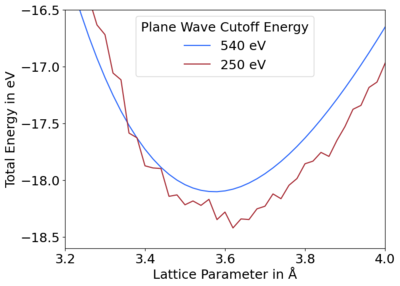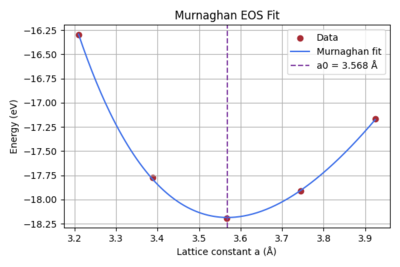Volume relaxation
Introduction
When relaxing the volume of cells, care must be taken. If too small an ENCUT or k-mesh are used, then discontinuities in energy vs. volume curves can be seen, cf. Fig. 1 and 2. This is due to an unconverged basis set being used. This creates unphysical forces, known as Pulay stress, that distort the cell structure away from equilibrium, decreasing the volume. This Pulay stress can be neglected in volume-conserving relaxations but becomes important in volume relaxations.


How to correct
The Pulay stress may be corrected in multiple ways. Generally, by calculating the relaxed structure with a larger basis set by increasing the ENCUT until convergence is reached:
- Set ENCUT to 1.3 × the default cutoff, or PREC=High in VASP.4.4. Note: this is the lower recommended limit.
- Re-run VASP with the default cutoff to obtain the final relaxed positions and cell parameters.
- Further increase the ENCUT and repeat Steps 1 and 2, until the structure no longer changes, i.e. is converged.
| Mind: This relaxation is done along all of the lattice vectors. If you want to relax only one and keep the others fixed, e.g. for the vacuum in a surface relaxation, then LATTICE_CONSTRAINTS may be used instead. This can constrain any of the three lattice vectors for orthorhombic cells, or specific rows and columns in the lattice matrix for non-orthorhombic cells. |
If volume relaxations are necessary, the following two procedures may be followed:
1. Volume relaxation
One way is to very accurately relax the structure in a series of calculations on one structure:
Step 1.
Relax from the starting structure (ISIF = 7; IBRION = 1, 2, or 3) with Gaussian or Methfessel-Paxton smearing (ISMEAR = 0 or 1). Note: other settings can be used for ISIF, e.g. 3, 6, or 8 but it is not recommended to relax more than one degree of freedom at a time. For instance,
ISMEAR = 0 ; SIGMA = 0.05 # change smearing to ISMEAR = 1 ; SIGMA = 0.2 for metals ISIF = 7 ; IBRION = 2; NSW = 20
Step 2.
Copy the CONTCAR to POSCAR and relax the structure again.
ISMEAR = 0 ; SIGMA = 0.05 # change smearing to ISMEAR = 1 ; SIGMA = 0.2 for metals ISIF = 7 ; IBRION = 2; NSW = 20 ISTART = 1 # this keeps that energy cut-off constant, while updating the plane wave basis for the new cell volume
| Mind: In this procedure, it is important to set ISTART = 1 so that the basis is updated and the energy cut-off remains constant. If ISTART = 2, the basis remains constant, which will also keep the artificial, Pulay stress, i.e., it is an exact restart of the calculation in Step 1, with identically poor settings. |
Step 3.
Change the smearing method to the tetrahedron method (i.e. ISMEAR=-5) and perform a single point calculation, i.e. no relaxation of structure. These will give highly accurate energies.
ISMEAR = -5 # tetrahedron method NSW = 0
(Optional)
The previous steps should yield good energies. If there are still problems, such as the energy vs. volume curve remaining jagged, a few more additional steps may be tried:
Step 4a.
Try further increasing the ENCUT. Alternatively, improve the FFT grid by setting PREC=Accurate.
Step 4b.
To avoid additional computational cost due to increased cutoff energy, the STRESS output in VASP may be corrected using PSTRESS. The Pulay stress is only weakly dependent on volume and ionic configuration; it is mainly determined by the composition and basis set. A good estimation for it is given in the output, e.g.:
external pressure = -100.29567 kB
The difference in this pressure (between the desired and a very large ENCUT) may then be used to correct for the Pulay stress. PSTRESS is set to this difference, then all volume relaxations will take PSTRESS into account. It is important keep in mind that PSTRESS should only be used if increasing the cutoff is not a viable option.
- Perform two single point calculations, one for the default and one for the higher ENCUT.
- Find the external pressure in the OUTCAR file, e.g.:
external pressure = -1311.32 kB external pressure = -95.66 kB
- Find the difference between these external pressures. This is a good approximation of the Pulay stress. E.g.
difference in pressure = -1215.66 kB
PSTRESS = -1215.66
This results in structures similar to the higher cutoff at the cost of the default cutoff. We reiterate that PSTRESS should only be used if the higher cutoff is not a viable option, as this only improves the structure and not the energy.
2. Equation of state fitting
An alternative way to avoid relaxing the volume is to relax the ionic positions and cell shape for a fixed set of volumes, i.e., multiple POSCAR files. These are then fitted to an equation of state (EOS), e.g., Murnaghan [1]. As the Pulay stress is almost isotropic, only a constant value is added to the diagonal elements of the stress tensor [2]. Therefore, the relaxation for a fixed volume will yield highly accurate structures. This approach has the advantage of also providing the bulk modulus, and we have found it may be used safely with the default energy cutoff.
To fit the equation of state, you need to do calculations for a set of fixed volumes. The following steps are required:
Step 0.
Build an initial structure. You can take a unit cell for this and the experimental lattice parameter a (if known).
Step 1.
From your initial structure, create four additional structures with lattice parameters ±5 % and ±10 % of the initial lattice parameter. I.e., you should have 5 structures: 0.90a 0.95a 1.0a 1.05a 1.10a. The experimental lattice parameter of C diamond is 3.567 Å, so the value of X in the following POSCAR should be 3.210 3.389 3.567 3.745 3.924
cubic diamond X 0.0 0.5 0.5 0.5 0.0 0.5 0.5 0.5 0.0 2 Direct -0.125 -0.125 -0.125 0.125 0.125 0.125
Step 2.
Calculate the energy for each of your structures. You can use the following basic INCAR settings:
ISMEAR = 0; SIGMA = 0.05 # change smearing to ISMEAR = 1; SIGMA = 0.2 for metals IBRION = 0
For extremely accurate energies, you can instead use the tetrahedron method by setting ISMEAR = -5 (not for metals).
Step 3.
Find the lattice parameter and the energy for each structure:
#!/bin/bash
# Remove any previous data file
rm -f loop_lattice_constant.dat
# Loop through each subdirectory
for a in */; do
latt=$(grep "ALAT" "$a"/OUT* | awk '{print $3}')
E=$(grep "free e" "$a"/OUTCAR | awk '{print $5}')
echo "$latt $E" >> loop_lattice_constant.dat
done
Step 4.
Plot the lattice parameter against the energy and fit according to the Murnaghan equation (or another equation of state like the Birch-Murnaghan).
import numpy as np
import matplotlib.pyplot as plt
from scipy.optimize import curve_fit
# Load data
data = np.loadtxt("loop_lattice_constant.dat")
a = data[:, 0]
E = data[:, 1]
# Murnaghan EOS with fixed B0_prime
def murnaghan_fixed(a, E0, B0, a0):
B0_prime = 4.0 # fixed
V = a**3
V0 = a0**3
return E0 + (B0*V/V0/B0_prime) * (((V0/V)**B0_prime)/(B0_prime-1) + 1) - B0*V0/(B0_prime-1)
# Initial guess [E0, B0, a0]
initial_guess = [min(E), 1.0, a[np.argmin(E)]]
# Optional: bounds to avoid unphysical results
bounds = ([-np.inf, 0, min(a)], [np.inf, np.inf, max(a)])
# Fit with more iterations
popt, pcov = curve_fit(murnaghan_fixed, a, E, p0=initial_guess, bounds=bounds, maxfev=5000)
E0, B0, a0 = popt
print(f"Fitted parameters:\nE0 = {E0:.5f} eV, B0 = {B0:.5f} eV/ų, a0 = {a0:.5f} Å")
# Plot
a_fit = np.linspace(min(a), max(a), 200)
E_fit = murnaghan_fixed(a_fit, *popt)
plt.figure(figsize=(6,4))
plt.scatter(a, E, color='#A82C35', label='Data')
plt.plot(a_fit, E_fit, color='#3E70EA', label='Murnaghan fit')
plt.axvline(a0, color='#8342A4', linestyle='--', label=f'a0 = {a0:.3f} Å')
plt.xlabel('Lattice constant a (Å)')
plt.ylabel('Energy (eV)')
plt.title('Murnaghan EOS Fit')
plt.legend()
plt.grid(True)
plt.tight_layout()
plt.show()

In the above script, we have defined Murnaghan fit explicitly. Other tools, e.g., pymatgen, are available where EOS have been defined.
The optimized lattice parameter is the minimum of the Murnaghan fit. Five points are used here as an example; we recommend using more to improve the fit. Take a look at our tutorials for an alternative approach where a range of lattice parameters are taken for silicon.
Possible issues and advice on how to address them
When producing energy vs. volume plots, improper settings may result in jagged curves, cf. Fig. 1 and 2. This is commonly due to two reasons:
- Basis set incompleteness
The basis set is discrete and incomplete, so when the volume changes, additional plane waves are added. That causes small discontinuous changes in the energy.
- Use a larger plane wave cutoff, cf. Fig. 1. This is usually the preferred and simplest solution.
- Use more k-points, cf. Fig. 2.
Important: This solves the problem because the criterion for including a plane wave in the basis set is [math]\displaystyle{ \vert {\bf G} + {\bf k} \vert \lt {\bf G}_{\rm cut} }[/math]. This means at each k-point a different basis set is used, and additional plane waves are added at each k-point at different volumes. In turn, the energy vs. volume curve becomes smoother.
- Discontinuity of FFT grids
Different precisions of the FFT grid defined by PREC may be used, e.g. Normal or Accurate.
Mind: For PREC=Accurate, the FFT grids are chosen such that [math]\displaystyle{ {\bf H} \vert \phi\gt }[/math] is exactly evaluated. Whereas, for PREC=Normal the FFT grids are set to 3/4 of the value that is required for an exact evaluation of [math]\displaystyle{ {\bf H} \vert \phi\gt }[/math]. This introduces small errors when the volume changes, as the FFT grids change discontinuously. In other words, at each volume a different FFT grid is used, causing the energy to jump discontinuously between different volumes. For more details on FFT grids, see [3].
- Use PREC=Accurate
- Increase the plane wave cutoff.
- Set your FFT grids manually, and choose the one that is used per default for the largest volume.
References
- ↑ Murnaghan Equation of State, www.wikipedia.org (2024)
- ↑ One thing which is important to understand is that problems due to the Pulay stress can often be neglected if only volume conserving relaxations are performed. This is because the Pulay stress is usually almost uniform and it, therefore, changes the diagonal elements of the stress tensor only by a certain constant amount (see below). In addition, many calculations have shown that Pulay stress-related problems can also be reduced by performing calculations at different volumes using the same energy cutoff for each calculation (this is what VASP does by default) and fitting the final energies to an equation of state. This of course implies that the number of basis vectors is different at each volume. Calculations with many plane-wave codes have shown that such calculations yield reliable results for the lattice constants and the bulk modulus and other elastic properties even at relatively modest energy cutoffs. Constant energy cut-off calculations are less prone to errors caused by the basis set incompleteness than constant basis set calculations. But it should be kept in mind that volume changes and cell shape changes must be rather large in order to obtain reliable results from this method because within the limit of very small distortions the energy changes obtained with this method are equivalent to those obtained from the stress tensor and are therefore affected by the Pulay stress. Only volume changes of the order of 5-10 % guarantee that the errors introduced by the basis set incompleteness are averaged out.
- ↑ Introduction to ab-initio simulation in VASP
